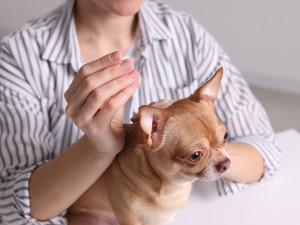
Share Article
In This Article:
Why Can’t Dogs Take Tylenol? Signs of Acetaminophen Poisoning Risk Even With Accidental Ingestion How to Prevent Tylenol Exposure What to Do if Your Dog Gets Ahold of Tylenol Alternative Canine Pain Relief Options
Dogs should never be given Tylenol or other acetaminophen-containing medications without strict veterinary guidance, as it can cause toxicity and fatal liver damage in canines. Unfortunately, dogs lack the liver enzymes to break high doses of the drug down effectively, which can lead to a fatal toxicosis.
Why can’t dogs take Tylenol?
Dogs shouldn’t be given Tylenol, (which contains acetaminophen) unless a veterinarian specifically prescribes it for them. Acetaminophen (also known as paracetamol outside the U.S.) has a narrow safety margin in dogs, and overdoses of the drug can be deadly. While Tylenol may be able to be used safely for short courses in some dogs, you should not try to dose it at home. A number of factors make it a bad idea to give your dog Tylenol at home:
It’s easy to overdose the medication and cause a severe, life-threatening toxicosis.
Different products contain varying concentrations of acetaminophen, making it easy to get the dose wrong.
Acetaminophen is often combined with other medications like decongestants that are also toxic to dogs.
Tylenol is contraindicated in many health conditions in dogs.
Acetaminophen has been proven to be effective in treating very few problems in dogs.
By itself, acetaminophen isn’t a great pain reliever in dogs — why risk toxicity for little to no effect?
So, under what conditions can a dog take Tylenol? Veterinarians will sometimes use products containing acetaminophen as a second or third option for treating pain. This most commonly occurs when the treatment course is very short and other medications cannot be used or when a dog has a terminal disease like bone cancer and palliative care outweighs possible toxicity concerns. Even in these situations, it is prescribed with care, precise dosing, and close monitoring.

Signs of acetaminophen poisoning
Taking too much acetaminophen can cause big problems for dogs. The drug is metabolized in the liver and kidneys (in a large overdose) and can damage both organs. The toxic byproducts produced as the drug is broken down can also cause problems with red blood cells and the eyes, paws, and face. The severity of signs will depend on the amount of acetaminophen ingested. Common symptoms include:
Appetite loss
Vomiting
Weakness/lethargy
Abnormal gum color: can be brownish, bluish, or pale
Bruising or bleeding
Yellow color to the gums, whites of the eyes, or skin
Facial and/or paw swelling
Abdominal pain
Dry or goopy eyes
Neurological symptoms like unsteadiness when walking or dull mentation
Increased thirst and urination
These symptoms can develop very quickly, with some signs appearing as soon as an hour after ingestion of the medication. Signs of liver failure, kidney failure, and red blood cell destruction will usually begin to show within a day or two, but it may take longer for the full extent of damage to become apparent.
Risk, even with accidental ingestion
The question of how much Tylenol can a dog take should be left up to your veterinarian. Despite their best intentions, pet parents can too easily poison their dogs by trying to dose Tylenol at home, so it’s best to just keep the medication out of mind and out of reach. But sometimes dogs will find their way into a cabinet, purse, or pill vial and eat a pill (or a jumbo-sized bottle of pills). Accidental ingestions, no matter how small, can cause problems for some dogs. It’s best to be proactive if you know or suspect your dog got into Tylenol.
What to do if your dog ingests Tylenol
If your dog gets into some Tylenol, the best bet is to start heading to either your vet’s office or an emergency clinic. Before you go, gather as much information as you can about how much your dog may have eaten: how many pills are possible, the pill strength, the exact product name (bring the bottle if you can), and any other medications possibly ingested.
The veterinarian will often try to induce vomiting to recover as much of the medication as possible. Most of these pills are designed to dissolve quickly (just think how fast they start working for a headache) so they may not show up when your dog barfs. Even if whole pills don’t come up in the vomit, the hope is that vomiting helps get some of the medication out before it is absorbed.
Calling a pet toxicology specialist like the ASPCA Animal Poison Control Centeropens in new tab and setting up a case will help immensely. Even experienced veterinarians rely on the veterinary toxicologists at these centers for the most up-to-date information and recommendations. These services do have a one-time fee for the consultation but will provide guidance throughout your dog’s treatment and recovery.
The treatment for acetaminophen ingestion will vary depending on how much was ingested, how much was recovered from vomiting, and your dog’s health profile. Therapy could be as simple as decontamination with vomiting induction, anti-nausea medication, and activated charcoal or as complex as a multi-day hospitalization with multiple IV and oral medications to counteract the effects of the acetaminophen.
How to prevent Tylenol exposure
Preventing Tylenol exposure for your dog relies on thinking ahead and being vigilant about medications. It only takes one slip-up for a curious pup to get into trouble. Some preventative measures to think about include:
1. Safely storing medications
Keep medications in a closed, preferably latched or locked cabinet that your dog can’t reach. Don’t rely on child-safe bottles or plastic containers to prevent problems. A determined dog can chew right through these.
2. Vigilance when using medications
When you take acetaminophen out to use it, be sure to keep track of it. Don’t leave pills or the bottle on the counter unattended and pick up any dropped pills immediately.
3. Training dogs not to counter surf
Dogs are naturally curious and want to know what’s happening on any surface they can reach. Train them early that countertops are not for them to stand on, sniff around, or eat from. This can help to prevent toxicities from foods dangerous to dogs as well.
4. Informing others in your household, especially kids, about the dangers of medications
Make sure that everyone in the house understands the dangers of letting your dog get into acetaminophen and other medications. Discuss ways to prevent accidental exposure.
Alternative canine pain relief options
Even though there are some situations where a vet may consider prescribing Tylenol for pain in dogs, it is not an approved or well-researched medication for use in dogs. There are alternatives available that are much safer, frequently prescribed, and approved for use in dogs. NSAIDs like carprofen, meloxicam, deracoxib, and firocoxib are commonly used for pain relief in dogs. Adjunct pain relief medications like gabapentin and CBD may help with some symptoms of pain and are generally considered safe but do not have FDA-approved status and their effects are not as well documented.
Depending on the type of pain your dog is experiencing, other methods may help with pain control. These adjunct home remedies can help with problems like arthritis without the worry about significant side effects. Alternative treatments can help lower your dog’s medication dosage, making long-term use safer. Some common treatments include:
Taking an approach that integrates healthy lifestyle changes with medication gives your dog the best chance at limiting pain and enjoying a great quality of life.
FAQs (People also ask):
Can dogs take baby Tylenol?
Dogs should not take Tylenol unless advised to do so by a veterinarian. Even baby Tylenol may contain too much acetaminophen for some dogs and could cause serious side effects.
Can a dog take Aspirin or Tylenol?
Dogs should not take Aspirin or Tylenol for pain. There are some specific situations where these medications may be recommended by a vet, but it’s best to avoid them otherwise due to concerns about toxicity.
Is there a Tylenol equivalent for dogs?
There are other pain medications approved for dogs that are safer and more effective than Tylenol. Some common drugs used for pain in dogs include carprofen, deracoxib, meloxicam, and firocoxib.
References:
Pathology in Practice. Acetaminophen (Paracetamol) Toxicosisopens in new tab
S-adenosyl-L-Methionine (SAMe) for the Treatment of Acetaminophen Toxicity in a Dogopens in new tab

Dr. Bartley Harrison, DVM
Dr. Bartley Harrison is a veterinarian with more than 19 years of experience. He has treated a variety of species in emergency and speciality practices for both large and small animals. His primary interests as a vet are emergency medicine and critical care.
Related articles
![Happy golden retriever dog on a walk with owner in woodsy yellow and orange fall setting with leaves on the dirt trail.]()
Home Remedies for Dog Joint Pain Relief
DIY ways to help your pup cope with the pain.
![Older dog playing with ball in a green field]()
Dog Arthritis Treatment: How to Relieve Arthritis Pain in Dogs
Tips for treating achy joints — from medications to massages.
![Woman with arm tattoos and wearing a black t-shirt stretching out the back legs of a Shiba Inu dog laying on a dark green mat]()
Does Your Dog Need a Massage?
Help your dog stay fit and flexible with these stretch techniques by a certified pet strength and conditioning specialist.
![Woman in striped dress shirt using an acupuncture needle on a senior Chihuahua dog]()
Can Dogs Get Acupuncture?
Find out if this complementary and alternative medicine is right for your pup.
![Dark-haired woman wearing a brown tank top petting her tan senior dog while under the covers in bed]()
How to Help Dogs With Intervertebral Disc Disease
If your dog has a herniated disc, acupuncture may be the key to relief.
![Sad looking white boxer sitting on a chair at a wooden table]()
How to Help Your Dog with Degenerative Myelopathy
The disease inhibits your dog's ability to use their legs. One writer shares how the condition is diagnosed — and how you can help your dog stay mobile.











